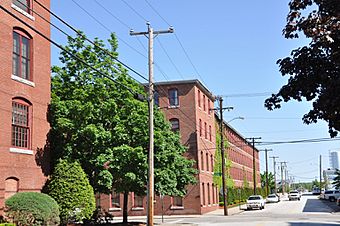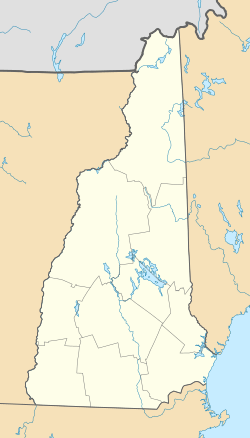Hoyt Shoe Factory facts for kids
Quick facts for kids |
|
|
Hoyt Shoe Factory
|
|
 |
|
| Location | 477 Silver and 170 Lincoln Sts., Manchester, New Hampshire |
|---|---|
| Area | 3 acres (1.2 ha) |
| Built | 1892 |
| Architect | Stevens, A.G. |
| NRHP reference No. | 85002777 |
| Added to NRHP | November 7, 1985 |
The Hoyt Shoe Factory is a historic building complex in Manchester, New Hampshire. It's made up of two large brick factory buildings. These buildings were once identical and face each other across Silver Street. Built in the 1890s, this factory was home to the biggest shoe maker in the city. Making shoes became very important as the city's textile (fabric) industry started to slow down. The complex was added to the National Register of Historic Places in 1985 because of its historical importance.
Contents
The Story of the Hoyt Shoe Factory
The Hoyt Shoe Factory complex is located about 1.5 miles (2.4 km) southeast of downtown Manchester. You can find it on both sides of Silver Street, near Lincoln Street.
What Do the Buildings Look Like?
Both factory buildings are four stories tall and made of brick. They show the typical style of Manchester's old mill buildings. They have many windows with arched tops along their long sides. The building on the north side has large sections that stick out, making it look like a "U" shape. The building on the south side has two smaller additions.
Why Are Some Buildings Not Included?
There was a third building built for Hoyt further west. However, it's not part of the National Register listing. This is because too many changes were made to it over time. These changes made it lose its original historic look.
A Look Back at History
One of the two main buildings was built in 1892. The other was finished in 1895. Both buildings also had more parts added to them in the early 1900s.
Who Designed the Factory?
These factories were designed by a special architect named Augustus G. Stevens. He designed them for Francis M. Hoyt. Along with other buildings nearby, this was the largest shoe factory in Manchester.
From Textiles to Shoes
The Hoyt Shoe Factory was built outside the city's main mill district. That area was mostly run by the Amoskeag Manufacturing Company, which made textiles. As the textile industry started to decline, making shoes became more and more important for the city's economy. The Hoyt Company made shoes here until 1971. After the 1930s, many other manufacturing businesses also started using parts of the factory space.



